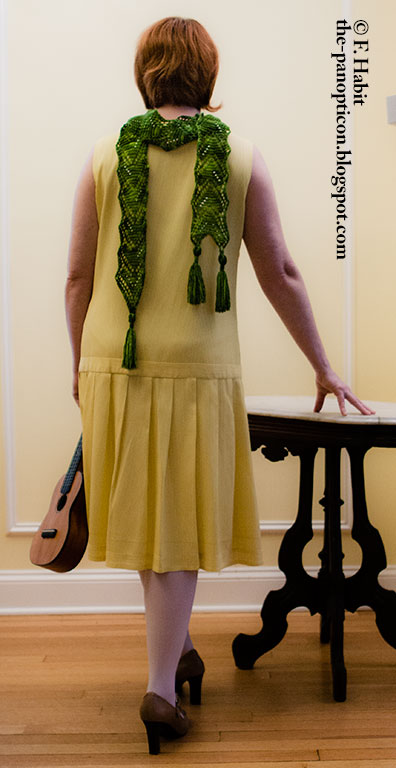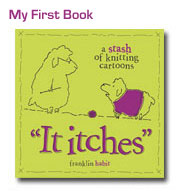I went to two high schools–one horrible, one merely mediocre. During my first of two years at the former, I was force-fed the Irish Christian Brothers' approved course of literary blood and guts. In keeping with the rest of the curriculum, it was intended to mold boys into men. Nasty, brutish, woman-thumping men.
We read the Odyssey, in a ridiculous prose translation that reduced Homer's epic to something less compelling than a Hardy Boys adventure. I still remember the blurb on the back cover insisting that "...no boy who reads it can ever fail to be thrilled." (I failed.)
We read The Red Badge of Courage, which was full of battle scenes we were meant to find alluring, not revolting. (Real men, we were told, love shooting and being shot at.)
And we were allowed one "free choice" book. As this was a Christian Brothers school, "free choice" was of course relative.
I picked Emma. Choice denied. Emma, said the teacher, was written by a woman. Men didn't choose to read books written by women. What was I, a pansy? (Um.)
I picked A Passage to India. Choice denied. E.M. Forster, said the teacher, was a sick homo. What was I, a pansy? (Um.)
I picked The Great Gatsby. Choice denied. It was for the juniors, said the teacher. You're not allowed to read it yet. You'll hurt yourself.
I honestly don't remember what I picked for the class. I do remember that I bought a copy of Gatsby with my babysitting money and read it as a silent Fuck You to the teacher.
I will not lie and say the experience turned me into a Fitzgerald fan. It didn't. I admire Fitzgerald in a chilly way, but if you banished me to a desert island with limited space on the raft for books I doubt that Daisy Buchanan and pals would make the cut.
What I did (and do) love about Gatsby was the parties, the houses, and the clothes.
This summer, after swearing I wouldn't, I went to see Baz Luhrman's film. I fell asleep during the second half, but before that I was surprisingly contented to just stare at the parties, the houses, and the clothes. They reminded me of why the book had sporadically carried me away
Luhrman's sets and costumes weren't "correct," but they felt correct. They felt like Fitzgerald's descriptions of the roaring twenties, which in time became the American popular imagination's sketchy idea of the roaring twenties.
It was this sketchy idea that I recently had to evoke in doing a piece of work for Babs Ausherman–known better to knitters all over the damn place as Miss Babs.
Miss Babs is a dyer, one of the best; and she has a yarn club. Lots of dyers have yarn clubs, but Miss Babs runs the only club that sends you places. Not literally, but in the comfort of your favorite chair. Each installment guides you through a different destination. As a souvenir you're given a yarn and coordinating pattern evocative of that place.
Or, in the case of my tour, that time and place. "What I want from you," said Babs, "is time travel."
Okay, sure. Why not?
So for my leg of the tour, which embarked this month, the knitters and I went to Chicago in 1923.
The tour part was easy. I live in Chicago, so I know my way around. And I borrowed a friend's time machine.

No, it's not that blue thing from Doctor Who, but it has reclining leather seats.
Getting all those knitters back to 1923 was a piece o' cake.
The tough part was the knitting pattern.
Because here's the thing: the past doesn't always look the way you think it did. The past doesn't always look the way you want it to. Rifling through my not-insignificant collection of 1920s knitting books, I realized that an authentic pattern wasn't going to cut it.
What folks often forget is that the world didn't remake itself to look like Radio City Music Hall on January 1, 1920. Art Deco was a machine-mad movement that started in France, and gradually–very gradually–began to exert an influence on international architecture and design. Lots of iconic American Deco wasn't even around in the twenties–including Radio City Music Hall, which opened in 1932.
In most of America, the 1920s simply didn't look the way we imagine the 1920s to have looked.
Knitting looked even less so. Knitting, I'm sorry to say, was undergoing a period of relative eclipse at the time. Not that nobody was knitting; but the people who were tended to be the people who are still, now, popularly imagined to be doing most of the knitting: spinsters, matrons, grandmothers, maiden aunts, little girls. This was not the smart set. The patterns produced for this market tended to be, at best, lukewarm. At worst, they all looked like tea cozies–even the sweaters.
You can imagine my dilemma when Babs told me she wanted a project for her subscribers that would really roar, and all I could find were hats that looked like tea cozies. I fell in love with one of those hats, by the way, and though it wasn't right for the Knitting Tour I couldn't resist re-working it in Quince and Co. Lark for the Deep Fall 2013 issue of Knitty:
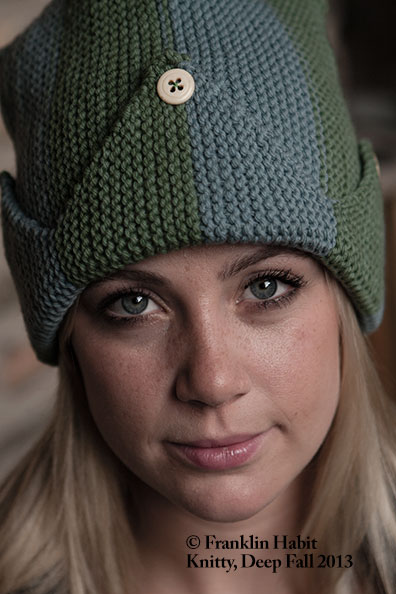
For Babs, ultimately I took as my inspiration a real piece of period clothing: the very long, very thin "lavalier" scarf. But whereas a period scarf would have been woven–likely a fine silk chiffon–mine had to be knit.
I asked for colorway that would mimic jade, and boy did I get it. I mixed it with silver beads, silver and jade being a classic Deco combination. Babs knows her way around a dye pot.
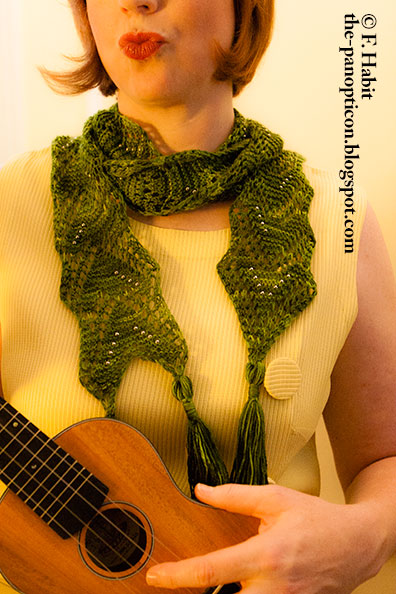
Deco motifs are tough in lace–I've never seen one that satisfies me completely (including mine). But I did my level best, and worked up an arrow that shoots from one end of the scarf to the other.
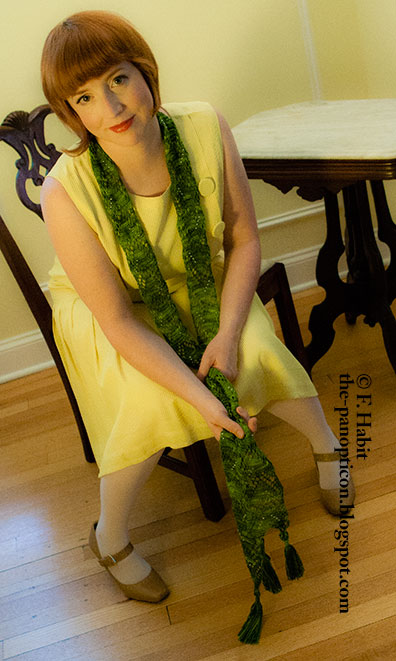
The result is a contradiction. I attempted to evoke period knitting...in a manner wholly inappropriate to the the knitting of the period.
Vo-de-o-do-do.
